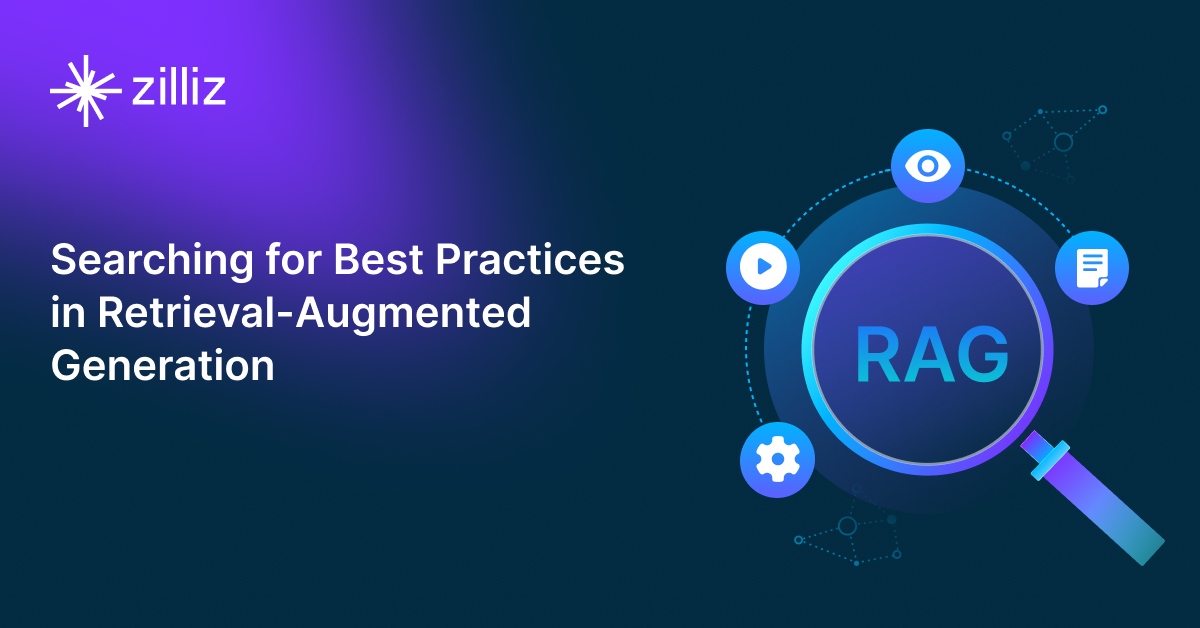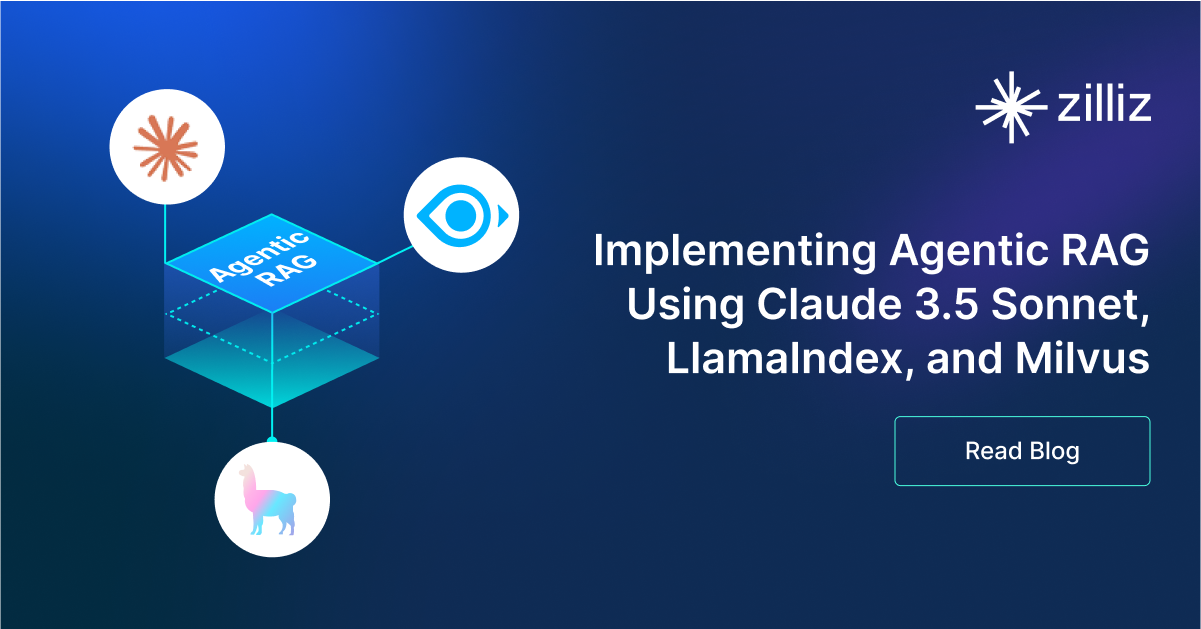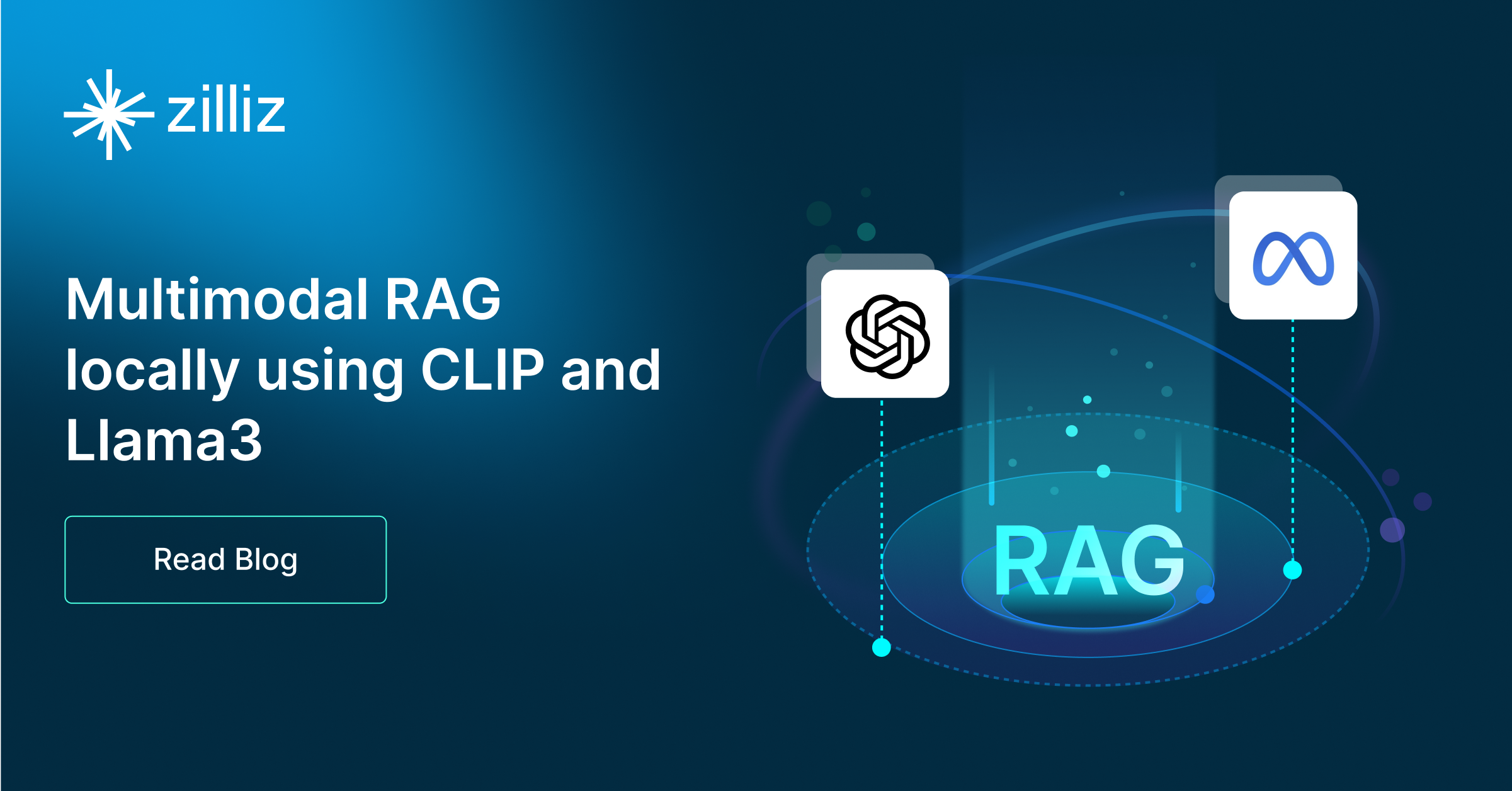Build RAG Chatbot with LangChain, Zilliz Cloud, Google Vertex AI Claude 3.5 Haiku, and NVIDIA embed-qa-4
Introduction to RAG
Retrieval-Augmented Generation (RAG) is a game-changer for GenAI applications, especially in conversational AI. It combines the power of pre-trained large language models (LLMs) like OpenAI’s GPT with external knowledge sources stored in vector databases such as Milvus and Zilliz Cloud, allowing for more accurate, contextually relevant, and up-to-date response generation. A RAG pipeline usually consists of four basic components: a vector database, an embedding model, an LLM, and a framework.
Key Components We'll Use for This RAG Chatbot
This tutorial shows you how to build a simple RAG chatbot in Python using the following components:
- LangChain: An open-source framework that helps you orchestrate the interaction between LLMs, vector stores, embedding models, etc, making it easier to integrate a RAG pipeline.
- Zilliz Cloud: a fully managed vector database-as-a-service platform built on top of the open-source Milvus, designed to handle high-performance vector data processing at scale. It enables organizations to efficiently store, search, and analyze large volumes of unstructured data, such as text, images, or audio, by leveraging advanced vector search technology. It offers a free tier supporting up to 1 million vectors.
- Google Vertex AI Claude 3.5 Haiku: This advanced AI model leverages Google's Vertex AI platform, offering robust capabilities for natural language processing and data analysis. Notable for its versatility and scalability, it excels in complex tasks like content generation and sentiment analysis, making it ideal for enterprises aiming to enhance decision-making with AI-driven insights.
- NVIDIA embed-qa-4: This model specializes in question answering tasks, leveraging cutting-edge embedding techniques to enhance accuracy and comprehension. Its strengths lie in understanding context and retrieving precise information effectively. Ideal for applications in customer support, educational platforms, and any domain needing rapid, context-aware responses to user inquiries.
By the end of this tutorial, you’ll have a functional chatbot capable of answering questions based on a custom knowledge base.
Note: Since we may use proprietary models in our tutorials, make sure you have the required API key beforehand.
Step 1: Install and Set Up LangChain
%pip install --quiet --upgrade langchain-text-splitters langchain-community langgraph
Step 2: Install and Set Up Google Vertex AI Claude 3.5 Haiku
pip install -qU "langchain[google-vertexai]"
# Ensure your VertexAI credentials are configured
from langchain.chat_models import init_chat_model
llm = init_chat_model("claude-3-5-haiku@20241022", model_provider="google_vertexai")
Step 3: Install and Set Up NVIDIA embed-qa-4
pip install -qU langchain-nvidia-ai-endpoints
import getpass
import os
if not os.environ.get("NVIDIA_API_KEY"):
os.environ["NVIDIA_API_KEY"] = getpass.getpass("Enter API key for NVIDIA: ")
from langchain_nvidia_ai_endpoints import NVIDIAEmbeddings
embeddings = NVIDIAEmbeddings(model="NV-Embed-QA")
Step 4: Install and Set Up Zilliz Cloud
pip install -qU langchain-milvus
from langchain_milvus import Zilliz
vector_store = Zilliz(
embedding_function=embeddings,
connection_args={
"uri": ZILLIZ_CLOUD_URI,
"token": ZILLIZ_CLOUD_TOKEN,
},
)
Step 5: Build a RAG Chatbot
Now that you’ve set up all components, let’s start to build a simple chatbot. We’ll use the Milvus introduction doc as a private knowledge base. You can replace it with your own dataset to customize your RAG chatbot.
import bs4
from langchain import hub
from langchain_community.document_loaders import WebBaseLoader
from langchain_core.documents import Document
from langchain_text_splitters import RecursiveCharacterTextSplitter
from langgraph.graph import START, StateGraph
from typing_extensions import List, TypedDict
# Load and chunk contents of the blog
loader = WebBaseLoader(
web_paths=("https://milvus.io/docs/overview.md",),
bs_kwargs=dict(
parse_only=bs4.SoupStrainer(
class_=("doc-style doc-post-content")
)
),
)
docs = loader.load()
text_splitter = RecursiveCharacterTextSplitter(chunk_size=1000, chunk_overlap=200)
all_splits = text_splitter.split_documents(docs)
# Index chunks
_ = vector_store.add_documents(documents=all_splits)
# Define prompt for question-answering
prompt = hub.pull("rlm/rag-prompt")
# Define state for application
class State(TypedDict):
question: str
context: List[Document]
answer: str
# Define application steps
def retrieve(state: State):
retrieved_docs = vector_store.similarity_search(state["question"])
return {"context": retrieved_docs}
def generate(state: State):
docs_content = "\n\n".join(doc.page_content for doc in state["context"])
messages = prompt.invoke({"question": state["question"], "context": docs_content})
response = llm.invoke(messages)
return {"answer": response.content}
# Compile application and test
graph_builder = StateGraph(State).add_sequence([retrieve, generate])
graph_builder.add_edge(START, "retrieve")
graph = graph_builder.compile()
Test the Chatbot
Yeah! You've built your own chatbot. Let's ask the chatbot a question.
response = graph.invoke({"question": "What data types does Milvus support?"})
print(response["answer"])
Example Output
Milvus supports various data types including sparse vectors, binary vectors, JSON, and arrays. Additionally, it handles common numerical and character types, making it versatile for different data modeling needs. This allows users to manage unstructured or multi-modal data efficiently.
Optimization Tips
As you build your RAG system, optimization is key to ensuring peak performance and efficiency. While setting up the components is an essential first step, fine-tuning each one will help you create a solution that works even better and scales seamlessly. In this section, we’ll share some practical tips for optimizing all these components, giving you the edge to build smarter, faster, and more responsive RAG applications.
LangChain optimization tips
To optimize LangChain, focus on minimizing redundant operations in your workflow by structuring your chains and agents efficiently. Use caching to avoid repeated computations, speeding up your system, and experiment with modular design to ensure that components like models or databases can be easily swapped out. This will provide both flexibility and efficiency, allowing you to quickly scale your system without unnecessary delays or complications.
Zilliz Cloud optimization tips
Optimizing Zilliz Cloud for a RAG system involves efficient index selection, query tuning, and resource management. Use Hierarchical Navigable Small World (HNSW) indexing for high-speed, approximate nearest neighbor search while balancing recall and efficiency. Fine-tune ef_construction and M parameters based on your dataset size and query workload to optimize search accuracy and latency. Enable dynamic scaling to handle fluctuating workloads efficiently, ensuring smooth performance under varying query loads. Implement data partitioning to improve retrieval speed by grouping related data, reducing unnecessary comparisons. Regularly update and optimize embeddings to keep results relevant, particularly when dealing with evolving datasets. Use hybrid search techniques, such as combining vector and keyword search, to improve response quality. Monitor system metrics in Zilliz Cloud’s dashboard and adjust configurations accordingly to maintain low-latency, high-throughput performance.
Google Vertex AI Claude 3.5 Haiku optimization tips
Claude 3.5 Haiku on Google Vertex AI is optimized for both efficiency and improved response quality. Enhance retrieval by applying relevance filtering before passing documents to the model. Keep prompts structured with clear separators between user queries and retrieved context. Adjust temperature (0.1–0.3) for optimal factual accuracy while tuning top-p for output control. Use Google Cloud’s serverless scaling to handle large query loads without performance degradation. Implement caching strategies for frequently requested information to reduce redundant API calls. If used alongside larger models, deploy Haiku for rapid responses in latency-sensitive scenarios, reserving complex reasoning for higher-tier models.
NVIDIA embed-qa-4 optimization tips
NVIDIA embed-qa-4 is a high-performance embedding model optimized for question-answering tasks in RAG systems. Improve retrieval efficiency by generating embeddings at both the document and sentence levels, allowing for granular matching. Use similarity threshold tuning to balance precision and recall when retrieving documents. For large-scale applications, employ GPU-accelerated ANN search frameworks such as FAISS with optimized indexing parameters. Cache frequently used embeddings to reduce API overhead and speed up query processing. When handling dynamic knowledge bases, implement scheduled re-embedding of updated documents to maintain search relevance. Consider fine-tuning retrieval pipelines by integrating metadata-based filters alongside vector search for improved contextual accuracy.
By implementing these tips across your components, you'll be able to enhance the performance and functionality of your RAG system, ensuring it’s optimized for both speed and accuracy. Keep testing, iterating, and refining your setup to stay ahead in the ever-evolving world of AI development.
RAG Cost Calculator: A Free Tool to Calculate Your Cost in Seconds
Estimating the cost of a Retrieval-Augmented Generation (RAG) pipeline involves analyzing expenses across vector storage, compute resources, and API usage. Key cost drivers include vector database queries, embedding generation, and LLM inference.
RAG Cost Calculator is a free tool that quickly estimates the cost of building a RAG pipeline, including chunking, embedding, vector storage/search, and LLM generation. It also helps you identify cost-saving opportunities and achieve up to 10x cost reduction on vector databases with the serverless option.
 Calculate your RAG cost
Calculate your RAG cost
What Have You Learned?
What have you learned? Well, you've just taken a remarkable journey through the exciting landscape of Retrieval-Augmented Generation (RAG) systems! This tutorial brought together the powerful LangChain framework, the lightning-fast Zilliz Cloud vector database, the dynamic conversational capabilities of Google Vertex AI Claude 3.5 Haiku, and the innovative embedding model from NVIDIA embed-qa-4. Let’s take a moment to celebrate how these components fit together like a well-tuned symphony!
With LangChain as your guiding framework, you've seen how it seamlessly orchestrates the interaction between a vector database and a large language model (LLM), acting as the backbone that unifies their individual strengths. The vector database enhances your ability to perform rapid searches, providing quick access to relevant information that forms the crux of any intelligent application. Meanwhile, the LLM powers conversational interactions, bringing an added layer of intelligence that understands and engages with users naturally.
And let’s not forget how the embedding model enriches this entire system by producing deep semantic representations that capture context like never before! The optimization tips and the free cost calculator you learned about will empower you to refine your RAG applications further, making them even more efficient and cost-effective.
Now that you have this incredible knowledge and toolkit at your fingertips, it's time to dive in! Start building, optimizing, and innovating your own RAG solutions. There’s an entire world of possibilities waiting for you, and you have the means to explore it. Go forth, unleash your creativity, and let your ideas be the next breakthrough in conversational AI!
Further Resources
🌟 In addition to this RAG tutorial, unleash your full potential with these incredible resources to level up your RAG skills.
- How to Build a Multimodal RAG | Documentation
- How to Enhance the Performance of Your RAG Pipeline
- Graph RAG with Milvus | Documentation
- How to Evaluate RAG Applications - Zilliz Learn
- Generative AI Resource Hub | Zilliz
We'd Love to Hear What You Think!
We’d love to hear your thoughts! 🌟 Leave your questions or comments below or join our vibrant Milvus Discord community to share your experiences, ask questions, or connect with thousands of AI enthusiasts. Your journey matters to us!
If you like this tutorial, show your support by giving our Milvus GitHub repo a star ⭐—it means the world to us and inspires us to keep creating! 💖
- Introduction to RAG
- Key Components We'll Use for This RAG Chatbot
- Step 1: Install and Set Up LangChain
- Step 2: Install and Set Up Google Vertex AI Claude 3.5 Haiku
- Step 3: Install and Set Up NVIDIA embed-qa-4
- Step 4: Install and Set Up Zilliz Cloud
- Step 5: Build a RAG Chatbot
- Optimization Tips
- RAG Cost Calculator: A Free Tool to Calculate Your Cost in Seconds
- What Have You Learned?
- Further Resources
- We'd Love to Hear What You Think!
Content
Vector Database at Scale
Zilliz Cloud is a fully-managed vector database built for scale, perfect for your RAG apps.
Try Zilliz Cloud for Free


